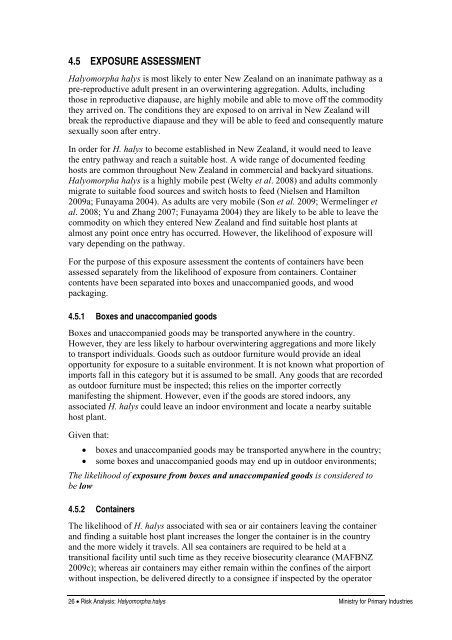Risk analysis of Halyomorpha halys - Biosecurity New Zealand
Risk analysis of Halyomorpha halys - Biosecurity New Zealand
Risk analysis of Halyomorpha halys - Biosecurity New Zealand
You also want an ePaper? Increase the reach of your titles
YUMPU automatically turns print PDFs into web optimized ePapers that Google loves.
4.5 EXPOSURE ASSESSMENT<br />
<strong>Halyomorpha</strong> <strong>halys</strong> is most likely to enter <strong>New</strong> <strong>Zealand</strong> on an inanimate pathway as a<br />
pre-reproductive adult present in an overwintering aggregation. Adults, including<br />
those in reproductive diapause, are highly mobile and able to move <strong>of</strong>f the commodity<br />
they arrived on. The conditions they are exposed to on arrival in <strong>New</strong> <strong>Zealand</strong> will<br />
break the reproductive diapause and they will be able to feed and consequently mature<br />
sexually soon after entry.<br />
In order for H. <strong>halys</strong> to become established in <strong>New</strong> <strong>Zealand</strong>, it would need to leave<br />
the entry pathway and reach a suitable host. A wide range <strong>of</strong> documented feeding<br />
hosts are common throughout <strong>New</strong> <strong>Zealand</strong> in commercial and backyard situations.<br />
<strong>Halyomorpha</strong> <strong>halys</strong> is a highly mobile pest (Welty et al. 2008) and adults commonly<br />
migrate to suitable food sources and switch hosts to feed (Nielsen and Hamilton<br />
2009a; Funayama 2004). As adults are very mobile (Son et al. 2009; Wermelinger et<br />
al. 2008; Yu and Zhang 2007; Funayama 2004) they are likely to be able to leave the<br />
commodity on which they entered <strong>New</strong> <strong>Zealand</strong> and find suitable host plants at<br />
almost any point once entry has occurred. However, the likelihood <strong>of</strong> exposure will<br />
vary depending on the pathway.<br />
For the purpose <strong>of</strong> this exposure assessment the contents <strong>of</strong> containers have been<br />
assessed separately from the likelihood <strong>of</strong> exposure from containers. Container<br />
contents have been separated into boxes and unaccompanied goods, and wood<br />
packaging.<br />
4.5.1 Boxes and unaccompanied goods<br />
Boxes and unaccompanied goods may be transported anywhere in the country.<br />
However, they are less likely to harbour overwintering aggregations and more likely<br />
to transport individuals. Goods such as outdoor furniture would provide an ideal<br />
opportunity for exposure to a suitable environment. It is not known what proportion <strong>of</strong><br />
imports fall in this category but it is assumed to be small. Any goods that are recorded<br />
as outdoor furniture must be inspected; this relies on the importer correctly<br />
manifesting the shipment. However, even if the goods are stored indoors, any<br />
associated H. <strong>halys</strong> could leave an indoor environment and locate a nearby suitable<br />
host plant.<br />
Given that:<br />
boxes and unaccompanied goods may be transported anywhere in the country;<br />
some boxes and unaccompanied goods may end up in outdoor environments;<br />
The likelihood <strong>of</strong> exposure from boxes and unaccompanied goods is considered to<br />
be low<br />
4.5.2 Containers<br />
The likelihood <strong>of</strong> H. <strong>halys</strong> associated with sea or air containers leaving the container<br />
and finding a suitable host plant increases the longer the container is in the country<br />
and the more widely it travels. All sea containers are required to be held at a<br />
transitional facility until such time as they receive biosecurity clearance (MAFBNZ<br />
2009c); whereas air containers may either remain within the confines <strong>of</strong> the airport<br />
without inspection, be delivered directly to a consignee if inspected by the operator<br />
26 <strong>Risk</strong> Analysis: <strong>Halyomorpha</strong> <strong>halys</strong> Ministry for Primary Industries
















